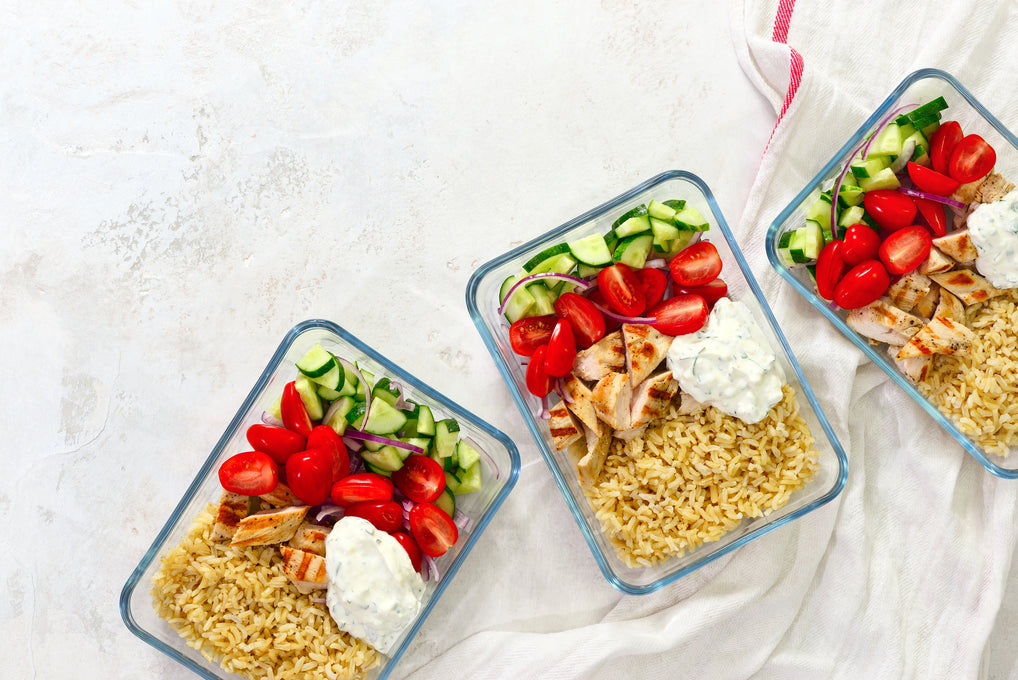Your guide to: Meal Prep
12th April 2019 / Health
Your guide to: Meal Prep
Zoe Milkowski

Meal “prep” or “prepping” is the process of preparing whole meals in advance to make mealtimes more convenient, cutting back on the time needed to prepare and cook food. Meal prepping is favoured by people with busy schedules who want to ensure that they are still meeting their nutritional goals and not falling into bad habits of choosing something fast and unhealthy when hunger strikes.
So if you want to learn how to cut back on cooking time, have healthy and balanced meals already prepared and waiting for you when you get home after work, read on!
As with any food plan, diet or lifestyle regime there is no “one size” fits all. Different things work for different people and it often takes time and a lot of trial and error to find the method that works for you.
Make extra
The most obvious way to meal prep (and the method that most people start with) is to simply make extra every time you cook a meal. For example, if you make yourself 2 portions of dinner on Sunday evening you can have one for dinner and take the other one into work for lunch on Monday. Another option here could be to further split your second portion and add each half portion to salad or veggies to make 2 extra meals.
+ This option gives way to a lot of different combinations and variety, which is great if you get bored of eating the same thing.
- A drawback here is that you are still spending time cooking during the week which may not work for people with very hectic weekday schedules.
Batch cook
This method is arguably the more traditional method of meal prep and brings to mind images of hundreds of tupperware boxes and slaving away in the kitchen all Sunday afternoon. It is an art to perfect and takes some effort and dedication but batch cooking really does save a lot of time in the long run.
The best way to go about this method would be to decide on a few different, versatile recipes that you know you won’t get bored of. What we mean by versatile is using ingredients that you wouldn’t mind eating at lunch or dinner-times and that can be paired with different things. For example, if you make a big batch of lean beef Bolognese sauce you can pair this with spaghetti for one meal and then bulk it up with salad leaves or veggies for another.
1. The best way to start with batch cooking for the week ahead would be to sit down and draw up a schedule. Work out how many meals you will need for the week (this can include breakfasts as well if you like). Remember to factor in social plans like dining out or eating over at a friend’s house so you don’t make too much food that could go to waste.
2. Next, decide on your recipes. Start with a small number of tried and tested recipes that you already know. Make sure that every meal plan is based around:
- a protein source
- is bulked up with fibrous and nutritious seasonal veg
- contains a smaller source of healthy fats and carbs.
The proportions of these food groups can all of course be slightly modified to create more variety. A good way of keeping it exciting could also be to add in some vegetarian or vegan meals (if you are normally a meat eater). Lots of easy veggie and vegan recipes can be found online if you find yourself stuck for ideas.
Another thing to remember when choosing your recipes is that by including recipes cooked by a variety of methods, your time in the kitchen when batch cooking could be even further cut down. What we mean here is, as a general rule of thumb, choose 1 oven-cooked recipe like slow roasted chicken and veg and 2 stovetop meals (a prawn stir fry and a lentil dhal). This way, you can be cooking all 3 batch meals at the same time.
You can also add wraps and salads into your meal plan to use up any leftovers. These require minimal prep and often involve no cooking at all.
3. You may want to do this step before choosing your recipes, but have a look in your cupboards and in the fridge for any leftovers that could be used in your meal prep for the next week. Most people will have a big bag of porridge oats sitting in a cupboard somewhere which can be used for your breakfasts in the week - you could prep overnight oats to take to work, sprinkle some oats over greek yoghurt and fruit or, of course, have a hot bowl of porridge drizzled with some honey for the colder mornings.
Once you know what you already have you can start making a grocery list for all the ingredients you need to buy on your weekly shop.
4. Possibly the most important part of meal prepping - how are you going to store all this food?
Having the right storage containers really does finesse the art of good meal prep. When buying your containers make sure they are airtight, microwave and freezer-safe and leak-proof. There’s nothing worse than a salad dressing explosion in your work bag!
From The Blog
-

25th February 2025 / Health
Empowering Women’s Health: Key Supplements for Well-being
Women’s health is a lifelong journey, with each stage presenting unique nutritional and wellness needs. From maintaining energy levels to supporting hormonal balance and bone health, the right comb...
Read article -

17th February 2025 / Health
Empowering Women’s Health: Lifestyle Tips and a Key Supplement for Perimenopause and Menopause
NaomiWomen’s health evolves through various life stages, and the transition into perimenopause and menopause brings unique challenges. During these phases, hormonal fluctuations can lead to symptom...
Read article -

10th February 2025 / Health / Products
The Best Foods and Drinks to Help Your Body Recover from Burnout
Burnout is a growing issue in today’s fast-paced work culture, leaving many people feeling exhausted, overwhelmed, and depleted. While rest and self-care are essential, nutrition plays a crucial ro...
Read article



